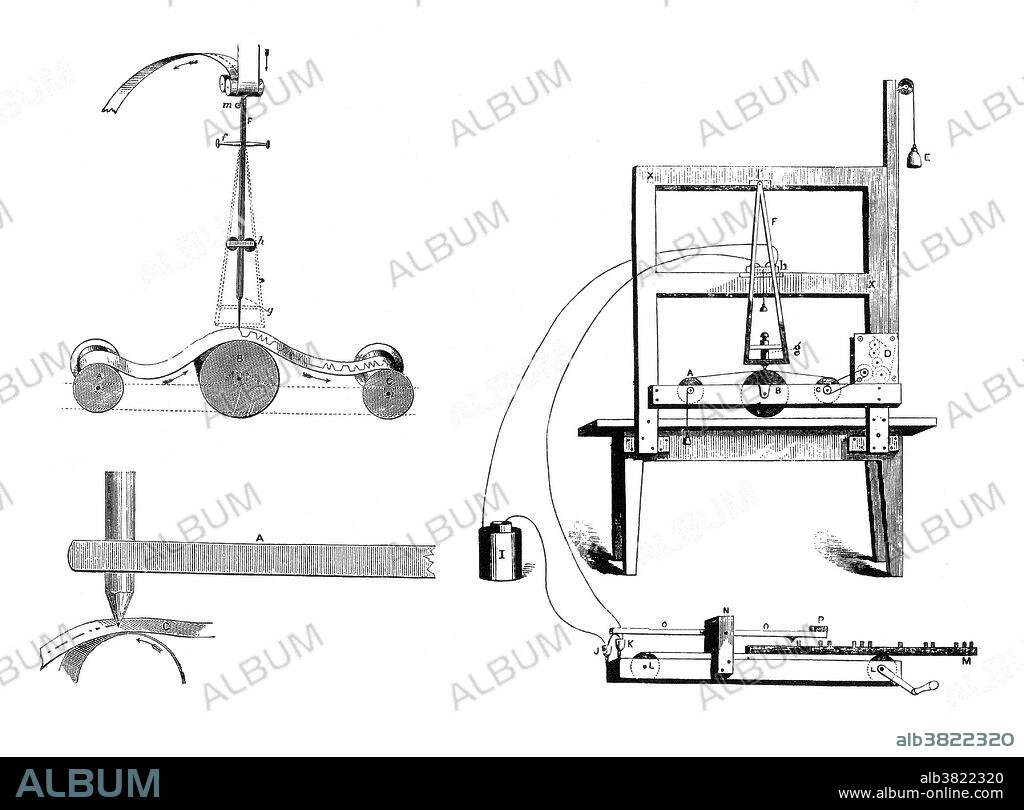alb3822320
Samuel Morse, Original Telegraph Receiver

|
Add to another lightbox |
|
Add to another lightbox |



Buy this image.
Select the use:

Title:
Samuel Morse, Original Telegraph Receiver
Caption:
An electrical telegraph was independently developed and patented in the United States in 1837 by Samuel Morse. Morse's first telegraph receiver made from a modified canvas stretcher. The original receiver was an electromagnet which actuated a pencil pressing down on a moving strip of tape. Each pulse from the sender made the pendulum swing. The paper tape then showed a series of sawtooth marks that corresponded with the ridges of the original slug and the message could be deciphered from the paper strip. Morse's original plan did not include a key. Instead, he copied the early printer's use of a composing stick. Slugs of metal wire were ridge along one face and each slug represented a letter. The entire message was mounted in a line of slugs and pushed along beneath a wooden finger that made and broke the circuit. His original code was too complicated to be memorized.
Personalities:
Credit:
Album / NYPL/Science Source
Releases:
Model: No - Property: No
Rights questions?
Rights questions?
Image size:
4350 x 3217 px | 40.0 MB
Print size:
36.8 x 27.2 cm | 14.5 x 10.7 in (300 dpi)
Keywords:
1830S • 1837 • 19TH CENTURY • AMERICA • AMERICAN • ART • ARTWORK • BW • CELEBRITIES • CELEBRITY • COMMUNICATION • DIAGRAM • DRAWING • ELECTRIC • ELECTRICAL SIGNALS • ELECTRICAL • ELECTRICITY • FAMOUS PEOPLE • FAMOUS • FIRST • HISTORIC • HISTORICAL • HISTORY • ILLUSTRATION • ILLUSTRATIONS • IMPORTANT • INVENTION • INVENTIVE • MASS COMMUNICATION • MORSE TELEGRAPH • MORSE'S TELEGRAPH • MORSE • MORSING • NOTABLE • ORIGINAL • PAPER TAPE • PUNCHED TAPE = PAPER TAPE • PUNCHED TAPE • RECEIVER • RECEPTION • SAM MORSE • SAMUEL FINLEY BREESE MORSE • SAMUEL MORSE • SCIENCE • SINGLE WIRE • TECHNOLOGICAL • TECHNOLOGY • TELE-COMMUNICATION • TELECOMMUNICATION • TELEGRAPH SYSTEM • TELEGRAPH • TELEGRAPHY • TICKER TAPE • TICKERTAPE • TRANSMISSION • UNITED STATES • US • USA • WELL-KNOWN
 Pinterest
Pinterest Twitter
Twitter Facebook
Facebook Copy link
Copy link Email
Email
